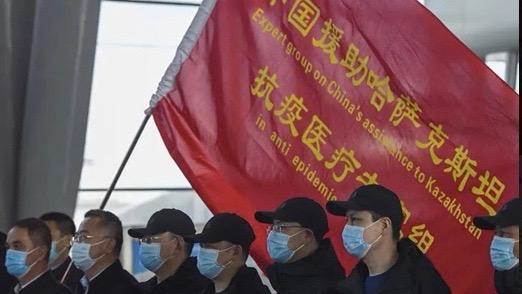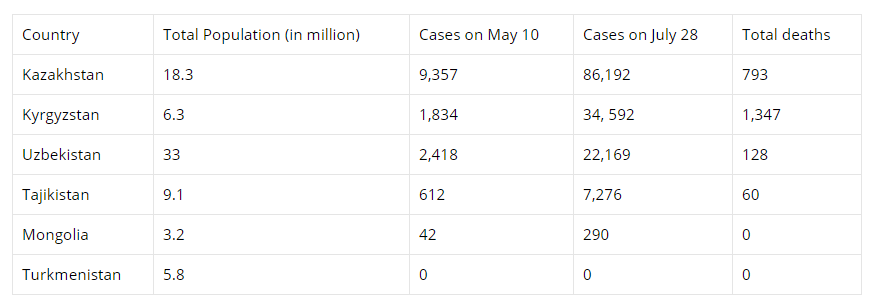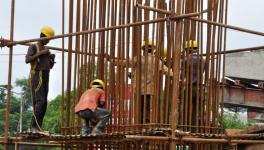COVID-19 Shows the Need to Rebuild Public Health Systems in Central Asian Countries

Chinese medical team in Kazakhstan. (Photo: Xinhua)
With the exception of Turkmenistan, most central Asian countries, namely Kazakhstan, Kyrgyzstan, Tajikistan, Uzbekistan and Mongolia, are going through a second wave of COVID-19 infections. The total number of new infections and deaths in these countries, which have already strained their health infrastructure and economy, is rising. With governments reluctant to re-impose restrictions, there is a grave possibility of these numbers spiraling out of control. This challenge can only be addressed through massive investments to revive the public health infrastructure that has been destroyed due to the neoliberal policies adopted since 1991.
The second wave
Turkmenistan is one of the rare countries in the world which has recorded no COVID-19 cases so far. This is despite it sharing a long land border with Iran, which is among the worst affected countries. The World Health Organization (WHO) team which visited Turkmenistan on a 10-day mission confirmed the official position that no cases had been found in the country. Various media organizations, including the US embassy in Turkmenistan, had reported an “outbreak”, with many also accusing the government of suppressing data and deliberately avoiding tests.
In the other countries in the central Asian region, the total number of new cases and deaths started rising in late June, with the situation worsening in July. Uzbekistan, which had just 10 officially declared deaths till May 10, now has over 128 deaths. Kazakhstan, the worst affected in the region, has well over 86,000 cases. In terms of total number of deaths, Kyrgyzstan is the worst hit with over 1,300 deaths.
Most of these countries were among the first ones to have implemented a comprehensive set of preventive measures, as early as in February when the pandemic was limited to China and a handful of other countries. Chinese experts visited some central Asian states in April and aided the governments in taking effective measures against the spread of the virus.
This may be the reason that these countries effectively managed the rate of new infections and deaths during the first wave (the first cases were reported in mid-March). They also extended lockdowns and closed their land borders with other countries, as well as imposed strict curfews and prevented all kinds of social gatherings. With the number of cases not rising significantly, most of the countries started lifting these restrictions by the middle of May.
However, due to a large number of migrants returning back from affected countries, such as Russia and some other European countries, as well as mismanagement of the quarantine process, the number of cases started rising again in June, leading to a second wave.

Social and economic effects
Most of the central Asian economies are trade dependent, with a massive reliance on remittances sent by migrants working outside these countries or the region. According to OECD estimates, there are between 2.7 to 4.2 million central Asians working in Russia alone. Remittances contribute between 10% to 30% of the GDPs of Uzbekistan, Kyrgyzstan and Tajikistan. With the host countries also facing economic problems due to the pandemic, remittances are bound to come down massively.
Gas and oil exports have also suffered, both in terms of prices and quantity. Countries with extractive economies such as Kazakhstan (about 20% of the GDP is dependent on extractive sectors which also provide the main source of income and employment), may suffer heavily in both social and economic aspects due to the global lockdowns.
As per IMF estimates, GDP growth in most of these countries (except in Turkmenistan and Uzbekistan) will turn negative this year with 3 to 4% contraction.
This is when just 38% of adults in central Asian countries have some kind of savings, according to OECD data. The World Bank has estimated that incomes in the informal sectors are expected to fall by one third. This would mean that a large number of people in central Asia will be dependent on the state for their survival and well-being.
Some governments, such as in Kazakhstan, have initiated certain cash transfer measures for common citizens losing their jobs. However, most have limited their policy responses to monetary relief measures for small and medium enterprises. The announcement of tax relief for corporates and individuals also means that state revenues will be compromised, reducing the chances for any large-scale social expenditure or relief for the vulnerable sections.
One OECD study also highlighted the effects of COVID-19 on women in the region. According to the report, the unpaid care work provided by women will see a manifold increase, as in other parts of the world, due to the lockdowns which have led to closure of schools, created food insecurity, and with members of the family falling ill, etc. This has also increased the incidence of domestic violence. According to the report, for example, cases of violence against women have increased by 67% during the lockdown in Kyrgyzstan.
Poor health infrastructure
Despite the rise in the number of infections and deaths, most governments in the region are reluctant to re-impose the lockdown and other restrictions. However, given the state of their health infrastructure and economy, this is a big risk.
In most of these countries, health expenditure as a percentage of the GDP is quite low, ranging from around 2% in Turkmenistan to around 7% in Tajikistan. Most of these countries have also seen massive deterioration in their public health systems since 1990, with ever increasing privatization. Except Kazakhstan, the average out-of-pocket expenditure on healthcare in the region is above 50%.
There has also been a consistent decline in the number of doctors per 1,000 population. For example, in Uzbekistan, the biggest country in terms of population in the region, the number of physicians has come down from over 3.4 per 1,000 in 1991 to 2.4 in 2014.
The systematic destruction of the public health systems of these states is due to the rising influence of neoliberal policies in the region, with a high rate of cronyism among the ruling classes. They have also failed to maintain the Soviet-era health infrastructure. Under pressure from global lending agencies and due to the lucrative market potential, much of the ruling class in the region has opted for privatization of the health sector in the name of ‘reforms’.
Today, most central Asian countries depend on imports for the majority of their medical equipment and medicinal needs, making them vulnerable to trade restrictions imposed due to COVID-19. There are several media reports of doctors expressing doubts about the capacity of the existing health infrastructure, which is on the verge of collapse, to tackle the crisis. The only solution is a massive injection to rebuild public healthcare in these countries.
A new approach is required
Central Asian states have experienced the effectiveness of a strong public health system in the past, and are surrounded by countries such as Iran and China which still have similar systems. Instead of aping the neo-liberal private model for healthcare from countries such as the US, which is currently facing its disastrous repercussions, countries in the region should learn from their neighbors and use this crisis as an opportunity to invest heavily in rebuilding public health infrastructure and implement social security measures to safeguard their populations now and in the future.
Get the latest reports & analysis with people's perspective on Protests, movements & deep analytical videos, discussions of the current affairs in your Telegram app. Subscribe to NewsClick's Telegram channel & get Real-Time updates on stories, as they get published on our website.
























